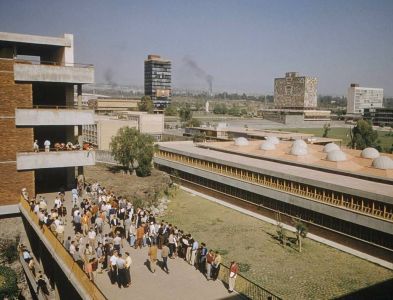The debates of plastic integration, modern architecture, and the development of new city forms come to the forefront in two major universities: the UNAM in Mexico City and the Universidad central in Caracas, Venezuela. The first exemplifies figurative, legible, and socially conscious art; the second, abstraction.», in: Carranza / Lara, 2014, p. 166–169 (dieser beitrag wurde verfasst in: englisch)
eingetragen von Alex Winiger am 18.09.2016, 22:46 (email senden)
«[…] All in all, the whole complex emphasizes the autonomy of each individual building through its placement on an open field that itself references its utopian garden-city precedents. In addition, the organization of the whole campus reflected the desire to balance science and technology with classical humanist culture. The design of the buildings was the work of a number of teams consisting of architects working with artists, the intended users of the buildings, and students from the School of Architecture. […]
The UNAM campus is, in effect, the result of a multiplicity of languages and styles working in close proximity with one another. While some attempts were made to create focal points and spatial continuities through the art that reinforced some of the large-scale planning techniques used, the fact that each building was designed by different groups of architects working with artists led to unique architectural and artistic expressions that, in many cases, do not create a coherent whole or dialogue. The CU in Caracas, in contrast, is the vision of a single individual with a clear goal of placing contemporary art at the service of the architectural and urban environment. The turn toward abstraction, both as a rejection of 'traditional' narrative art of Latin America and as a way to express modernity, allowed Villanuea to create a campus that favored the experiential and reinforced the formal aspects that he intended. Here, the scale – both of the art and the complex – is personal and intimate, whereas in Mexico it is monumental. This last distinction is crucial to the understanding of their uniqueness. The role of art in Mexico was still believed to be political and, thus, still bound by the requirements for legibility and communicability. At the Caracas campus, the responsibility lies more on the experiencing subjects moving through the structures and forms and understanding their place within the contruction of the modern nation.»
